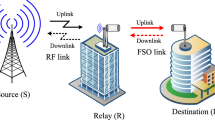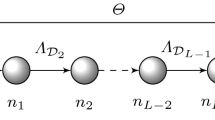Abstract
The paper considers level crossing rate (LCR) and average fade duration (AFD) of the product of independent and identically distributed (i.i.d) Nakagami-m (NM) and double NM squared (also known as gamma-gamma) random variables (RVs). The derived statistics are then directly applied to the radio-frequency (RF) - free space optical (FSO), dual-hop (DH), amplify-and-forward (AF) relaying system over non turbulent-induced-fading channels (nTIFCs) and turbulent-induced-fading channels (TIFCs). The obtained results for LCR and AFD of DH-AF, RF-FSO system over TIFCs and nTIFCs are numerically evaluated and graphically presented for various system model parameters.



Similar content being viewed by others
Availability of data and material
The authors confirm that the data supporting the findings of this study are available within the article.
References
Talha, B., & Pätzold, M. (2011). Channel models for mobile-to-mobile cooperative communication systems: A state of the art review. IEEE Vehicular Technology Magazine, 6(2), 33–43.
Park, J., Chae, C. B., & Yoon, G. (2017). Amplify-and-forward two-way relaying system over free-space optics channels. Journal of Communications and Networks, 19(5), 481–492.
Zhang, J., Pan, X., Pan, G., & Xie, Y. (2020). Secrecy analysis for multi-relaying RF-FSO systems with a multi-aperture destination. IEEE Photonics Journal, 12(2), 1–11.
Zhang, Y., Zhang, J., Yang, L., Ai, B., & Alouini, M. S. (2020). On the performance of dual-hop systems over mixed FSO/mmWave fading channels. IEEE Open Journal of the Communications Society, 1, 477–489.
Douik, A., Dahrouj, H., Al-Naffouri, T. Y., & Alouini, M. S. (2016). Hybrid radio/free-space optical design for next generation backhaul systems. IEEE Transactions on Communications, 64(6), 2563–2577.
Stefanovic, C., Pratesi, M., & Santucci, F. (2019). Second order statistics of mixed RF-FSO relay systems and its application to vehicular networks. In: IEEE ICC’19 ONF Symposium
Stefanovic, C., Pratesi, M., & Santucci, F. (2018). Second Performance evaluation of cooperative communications over fading channels in vehicular networks. In: Second URSI Atalntic Science Radio Meeting
Fawaz, W., Abou-Rjeily, C., & Assi, C. (2017). UAV-aided cooperation for FSO communication systems. IEEE Communications Magazine, 56(1), 70–75.
Bhargav, N., da Silva, C. R. N., Chun, Y. J., Leonardo, E. J., Cotton, S. L., & Yacoub, M. D. (2018). On the product of two \(\kappa\)-\(\mu\) random variables and its application to double and composite fading channels. IEEE Transactions on Wireless Communications, 17(4), 2457–2470.
Milosevic, N., Stefanovic, M., Nikolic, Z., Spalevic, P., & Stefanovic, C. (2018). Performance analysis of interference-limited mobile-to-mobile \(\kappa\)-\(\mu\) fading channel. Wireless Personal Communications, 101(3), 1685–1701.
Milosevic, N., Stefanovic, C., Nikolic, Z., Bandjur, M., & Stefanovic, M. (2018). First-and second-order statistics of interference-limited mobile-to- mobile Weibull fading channel. Journal of Circuits, Systems and Computers, 27(11), 1685–1701.
Stefanovic, C., Panic, S., Mladenovic, V., Jovkovic, S., & Stefanovic, M. (2020). Higher order statistics of cooperative mobile-to-mobile relay communications over composite fading channels. International Journal of Ad Hoc and Ubiquitous Computing, 35(2), 61–70.
Hajri, N., Khedhiri, R., & Youssef, N. (2020). On selection combining diversity in dual-hop relaying systems over double rice channels: Fade statistics and performance analysis. IEEE Access, 8, 72188–72203.
Li, S., Yang, L., Da Costa, D. B., Zhang, J., & Alouini, M. S. (2020). Performance analysis of mixed RF-UWOC dual-hop transmission systems. IEEE Transactions on Vehicular Technology, 69(11), 14043–14048.
Liu, W., Ding, J., Zheng, J., Chen, X., & Chih-Lin, X. I. (2020). Relay-assisted technology in optical wireless communications: A survey. IEEE Access, 8, 194384–194409.
Liang, H., Gao, C., Li, Y., Miao, M., & Li, X. (2020). Performance analysis of mixed MISO RF/SIMO FSO relaying systems. Optics Communications, 478, 126344.
Sharma, S., Madhukumar, A. S., & Swaminathan, R. (2020). Performance of dual-hop hybrid FSO/RF system with pointing errors optimization. In: Proceeding of the 2020 IEEE 91st vehicular technology conference (VTC2020-Spring), pp. 1–5
Panic, S., Mohanchenko, S., Stefanovic, C., & Stefanovic, M. (2020). First order outage statistics of asymmetrical RF-OW dual-hop relay communications. The University Thought-Publication in Natural Sciences, 10(1), 57–62.
Nor, N. A. M., Ghassemlooy, Z., Bohata, J., Saxena, P., Komanec, M., Zvanovec, S., et al. (2016). Experimental investigation of all-optical relay-assisted 10 Gb/s FSO link over the atmospheric turbulence channel. Journal of Lightwave Technology, 35(1), 45–53.
Juel, N. H. (2021). Secrecy performance analysis of mixed and exponentiated Weibull RF-FSO cooperative relaying system. IEEE Access, 9, 72342–72356.
Salhab, M. A., & Yang, L. (2021). Mixed RF/FSO relay networks: RIS-equipped RF source vs RIS-aided RF source. IEEE Wireless Communications Letters, 10(8), 1712–1716.
Liu, X., Gu, C., Guo, K., Cheng, M., Lin, M., & Zhu, W.-P. (2021). Robust beamforming and outage performance of uplink multiuser satellite-aerial-terrestrial networks with mixed RF-FSO channels. IEEE Photonics Journal, 13(4), 1–8.
Yura, H. T., & Hanson, S. G. (2010). Mean level signal crossing rate for an arbitrary stochastic process. Journal of the Optical Society of America A, 27(4), 797–807.
Jurado-Navas, A., Balsells, J. M. G., Castillo-Vazquez, M., Puerta-Notario, A., Monroy, I. T., & Olmos, J. J. V. (2017). Fade statistics of M-turbulent optical links. EURASIP Journal on Wireless Communications and Networking, 2017, 112. https://doi.org/10.1186/s13638-0170898-z.
Stefanovic, D., Stefanovic, C., Djosic, D., Milic, D., Rancic, D., & Stefanovic, M. (2019). LCR of the ratio of the product of two squared Nakagami-m random processes and its application to wireless. In: Proceedings of the 2019 18th IEEE international symposium INFOTEH-JAHORINA (INFOTEH), pp. 1–4
Issaid, C. B., & Alouini, M. S. (2019). Level crossing rate and average outage duration of free space optical links. IEEE Transactions on Communications, 67(9), 6234–6242.
Stefanovic, C., Panic, S., Djosic, D., Milic, D., & Stefanovic, M. (2021). On the second order statistics of N-hop FSO communications over N-gamma-gamma turbulence induced fading channels. Physical Communication, p. 101289
Vetelino, F. S., Young, C., & Andrews, L. (2007). Fade statistics and aperture averaging for Gaussian beam waves in moderate-to-strong turbulence. Applied Optics, 46(18), 3780–3789.
Kim, H. K., Higashino, T., Tsukamoto, K., & Komaki, S. (2011). Optical fading analysis considering spectrum of optical scintillation in terrestrial free-space optical channel. IEEE International Conference on Space Optical Systems and Applications, pp. 58–66
Le, H. D., & Pham, A. T. (2021). Level crossing rate and average fade duration of satellite-to-UAV FSO channels. IEEE Photonics Journal, 13(1), 1–14.
Stüber, L. G. (1996). Principles of mobile communication. Mass, USA: Kluwer Academic.
Suljovic, S., Milic, D., Panic, S., Stefanovic, C., & Stefanovic, M. (2020). Level crossing rate of macro diversity reception in composite Nakagami-m and Gamma fading environment with interference. Digital Signal Processing, 102, 102758. https://doi.org/10.1016/j.dsp.2020.102758.
Stefanovic, C., Jaksic, B., Spalevic, P., Panic, S., & Trajcevski, Z. (2013). Performance analysis of selection combining over correlated Nakagami-m fading channels with constant correlation model for desired signal and cochannel interference. Radioengineering, 22(4), 1176–1181.
Al-Ahmadi, S. (2014). The gamma-gamma signal fading model: A survey. IEEE Antennas and Propagation Magazine, 56(5), 245–260.
Petkovic, M., Zdravkovic, N., Stefanovic, C., & Djordjevic, G. (2014). Performance analysis of SIM-FSO system over Gamma–Gamma atmospheric channel. In: XLIX International Scientific Conference on Information, Communication and Energy Systems and Technologies—ICEST 2014, vol. 1, pp. 19–22
Datsikas, C. K., Peppas, K. P., Sagias, N. C., & Tombras, G. S. (2010). Serial free-space optical relaying communications over gamma-gamma atmospheric turbulence channels. IEEE/OSA Journal of Optical Communications and Networking, 2(8), 576–586.
Badarneh, O. S., Muhaidat, S., Sofotasios, P. C., Cotton, S. L., Rabie, K., & da Costa, D. B. (2018). The N\(*\) Fisher–Snedecor F cascaded fading model. In: Proceedings of the 14th international conference on wireless and mobile computing, networking and communications (WiMob), p. 1–7
Karagiannidis, G. K., Sagias, N. C., & Mathiopoulos, P. T. (2007). N* Nakagami: A novel stochastic model for cascaded fading channels. IEEE Transactions on Communications, 55(8), 1453–1458.
Bithas, P. S., Kanatas, A. G., da Costa, D. B., Upadhyay, P. K., & Dias, U. S. (2018). On the double-generalized gamma statistics and their application to the performance analysis of V2V communications. IEEE Transactions on Communications, 66(1), 448–460.
Stefanovic, C., Panic, S., Bhatia, V., & Kumar, N. (2021). On second-order statistics of the composite channel models for UAV-to-ground communications with UAV selection. IEEE Open Journal of the Communications Society, 2, 534–544. https://doi.org/10.1109/OJCOMS.2021.3064873.
Stefanovic, C., Panic, S. R., Bhatia, V., Kumar, N., & Sharma, S., (2021). On higher-order statistics of the channel model for UAV-to-ground communications. In: Proceedings of the 2021 IEEE 93rd vehicular technology conference (VTC2021-Spring), pp. 1–5. https://doi.org/10.1109/VTC2021-Spring51267.2021.9448754
Al-Hmood, H., Abbas, R. S., & Al-Raweshidy,H. S. (2020). Ratio of products of mixture gamma variates with applications to wireless communications. IEEE Transactions on Communications. arXiv preprint arXiv:2007.10826
Stankovic, A., Stefanovic, C., Sekulovic, N., Popovic, Z., & Stefanovic, M. (2012). The distribution of minimum of ratios of two random variables and its application in analysis of multi-hop systems. Radioengineering, 21(4), 1156–1162.
Matovic, A., Mekic, E., Sekulovic, N., Stefanovic, M., Matovic, M., & Stefanovic, C. (2013). The distribution of the ratio of the products of two independent: variates and its application in the performance analysis of relaying communication systems. Mathematical Problems in Engineering. https://doi.org/10.1155/2013/147106.
Hadzi-Velkov, Z., Zlatanov, N., & Karagiannidis, G. K. (2009). On the second order statistics of the multihop rayleigh fading channel. IEEE Transactions on Communications, 57(6), 1815–1823.
Al-Habash, A., Andrews, L. C., & Phillips, R. L. (2001). Mathematical model for the irradiance probability density function of a laser beam propagating through turbulent media. Optical Engineering, 40(8), 1554–1562.
Yacoub, M. D., Bautista, J. V., & Guedes, L. G. R. (1999). On higher order statistics of the Nakagami-m distribution. IEEE Transactions on Vehicular Technology, 48(3), 790–794.
Stefanovic, C., Djosic, D., Panic, S., Milic, D., & Stefanovic, M. (2020). A framework for statistical channel modeling in 5G wireless communication systems. 5G Multimedia communications: Technology, multiservices, deployment, CRC Press 2020, pp. 31–54
Gradshteyn, I. S., & Ryzhik, I. M. (2000). Table of Integrals, Series, and Products (6th ed.). New York: Academic.
Funding
This work has not been funded.
Author information
Authors and Affiliations
Contributions
The authors equally contributed to this work.
Corresponding author
Ethics declarations
Conflicts of interest/Competing interests
The authors declare that they have no conflict of interest or competing interests.
Code availability
Not applicable.
Additional information
Publisher's Note
Springer Nature remains neutral with regard to jurisdictional claims in published maps and institutional affiliations.
Appendix A
Appendix A
The variance of \(\dot{Z}_{SD}\) denoted as \(\sigma _{\dot{Z}_{SD}}^{2}\) and given by (8) is obtained under the assumption that \(\dot{Z}_{SD}\) is a zero-mean Gaussian RV [45]. Based on (1), the first derivative of \({Z}_{SD}\) can be written as:
where \(\dot{Y}_{NM,1}\), \(\dot{Y}_{NM,2}\) and \(\dot{Y}_{NM,3}\) are the first derivatives of \({Y}_{NM,1}\),\({Y}_{NM,2}\), and \({Y}_{NM,3}\), respectively. Since the linear transformation of the Gaussian RVs is a zero mean Gaussian RV, the variance of \(\sigma _{\dot{Z}_{SD}}^{2}\) can be expressed through the variances of \(\dot{Y}_{NM,1}\), \(\dot{Y}_{NM,2}\) and \(\dot{Y}_{NM,3}\) denoted as \(\sigma _{\dot{Y}_{NM,1}}^{2}, \sigma _{\dot{Y}_{NM,2}}^{2}\) and \(\sigma _{\dot{Y}_{NM,3}}^{2}\), respectively:
After using substitution \(y_{NM,1}=\frac{z_{SD}}{y_{NM,2}^{2}y_{NM,3}^{2}}\) and some algebra \(\sigma _{\dot{Z}_{SD}}^{2}\) is obtained as given by (8).
Rights and permissions
About this article
Cite this article
Stefanovic, C., Milovanovic, I., Panic, S. et al. LCR and AFD of the Products of Nakagami-m and Nakagami-m Squared Random Variables: Application to Wireless Communications Through Relays. Wireless Pers Commun 123, 2665–2678 (2022). https://doi.org/10.1007/s11277-021-09258-6
Accepted:
Published:
Issue Date:
DOI: https://doi.org/10.1007/s11277-021-09258-6




